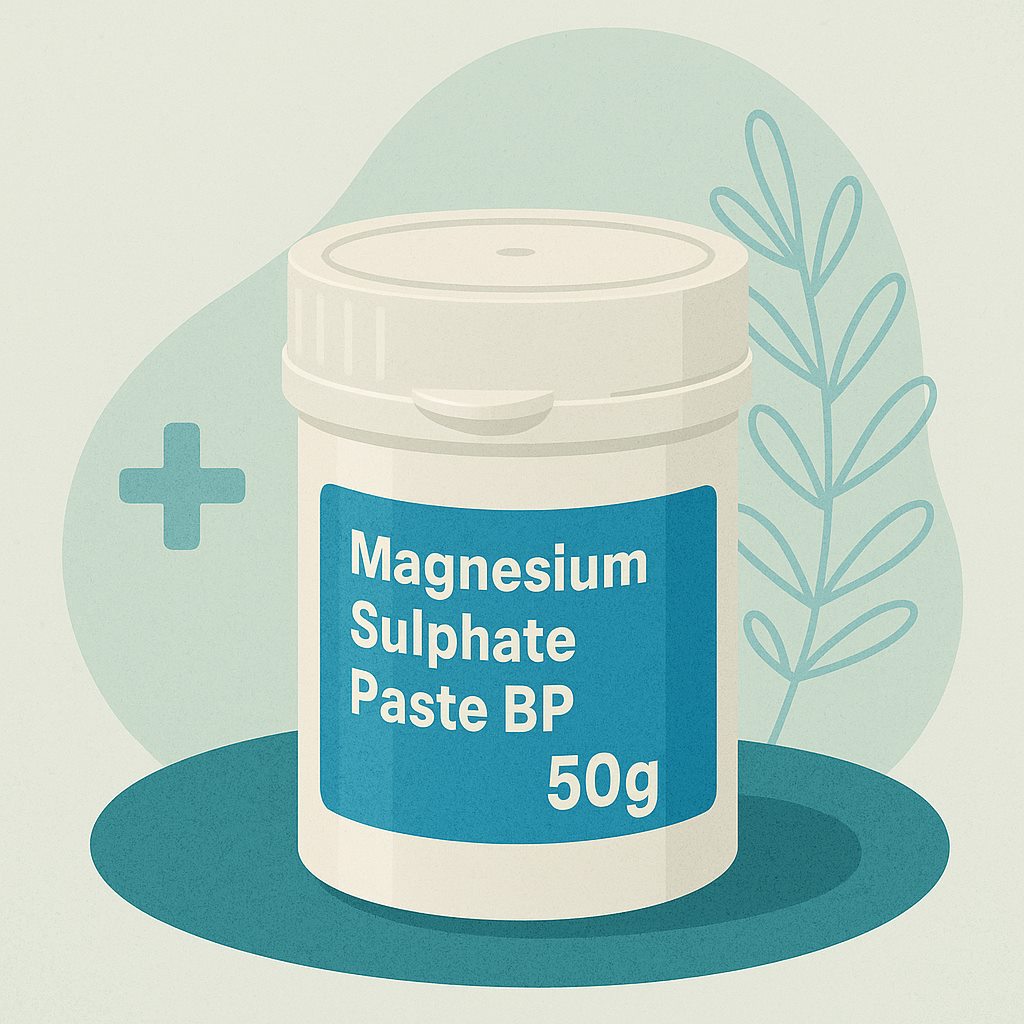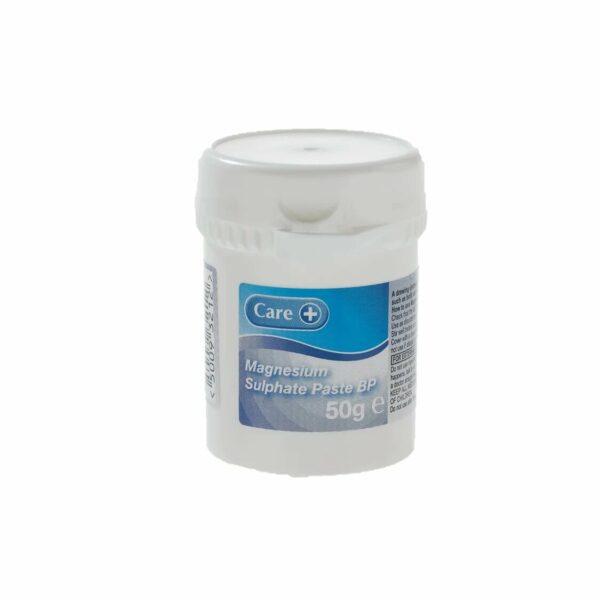Magnesium Sulphate Paste: Your Questions Answered
Magnesium Sulphate Paste, often known simply as “drawing paste,” is a traditional remedy found in many first-aid kits. Its primary ingredient, magnesium sulphate (also known as Epsom salt), has long been recognised for its ability to help with minor skin complaints, particularly those involving splinters or the need to draw out impurities.
If you’re considering using Magnesium Sulphate Paste or are curious about its applications, you likely have some questions. We’ve compiled the most common queries to provide clear, straightforward answers.

What does magnesium sulphate paste treat?
Magnesium Sulphate Paste is primarily used as a drawing agent. It is traditionally applied to help treat localised skin issues such as:
- Boils: It can help to draw out pus and infection, bringing the boil to a head.
- Carbuncles: Similar to boils, it aids in drawing out infection.
- Splinters: It can help to draw out small, embedded splinters or thorns from under the skin.
- Minor infected spots or wounds: Where there’s a need to draw out small amounts of pus or debris.
Does magnesium sulphate paste draw out pus?
Yes, one of the main actions of magnesium sulphate paste is its ability to draw out pus and moisture from boils, minor abscesses, and infected spots.
It works through osmosis; the high concentration of magnesium sulphate in the paste creates an osmotic gradient that helps pull fluid and exudate (like pus) from the affected area into the dressing.
How do you use magnesium sulphate paste on skin?
To use magnesium sulphate paste effectively:
- Clean the affected area: Gently wash and dry the skin around the boil, splinter, or affected spot.
- Apply the paste: Stir the paste if necessary. Apply a generous layer of magnesium sulphate paste directly onto the affected area.
- Cover with a dressing: Cover the paste with a clean, sterile dressing (like a gauze pad) and secure it with tape. This helps to keep the paste in place and prevent it from drying out too quickly.
- Change as needed: The dressing and paste should typically be changed at least once or twice a day, or as directed by your pharmacist or doctor.
How long do you leave magnesium sulphate paste on for?
Magnesium Sulphate Paste is typically left on the affected area for several hours at a time, usually under a dressing. Many people reapply it every 12 to 24 hours.
The duration will depend on the condition being treated and the advice of your healthcare provider. For specific guidance, always refer to the product label or consult a pharmacist.
Can I leave magnesium sulphate paste on overnight?
Yes, it is common practice to apply magnesium sulphate paste and leave it on overnight, covered with a dressing. This allows the paste to work for an extended period. Ensure the dressing is secure.
How many times a day can you use magnesium sulphate paste?
Typically, magnesium sulphate paste can be applied once or twice a day. The old dressing should be removed, the area cleaned, and fresh paste and dressing applied. Follow the instructions on the product packaging or the advice given by your pharmacist or doctor.
How long does it take for magnesium sulphate paste to work?
The time it takes for magnesium sulphate paste to work can vary. For drawing out splinters, you might see results within a day. For boils or infections, it may take a couple of days of consistent application for the boil to come to a head or for pus to be drawn out. If the condition doesn’t improve or worsens after a few days, consult your doctor.
What are the side effects of magnesium sulphate paste?
Side effects from topical magnesium sulphate paste are uncommon when used as directed. However, some individuals may experience:
- Skin irritation or redness at the application site, especially if they have sensitive skin.
- An allergic reaction, though rare. Symptoms could include rash, itching, or swelling.
If you experience significant irritation or signs of an allergic reaction, discontinue use and consult a healthcare professional.
Is magnesium sulphate paste safe for skin?
Yes, magnesium sulphate paste is generally considered safe for topical use on the skin for its intended purposes (like boils and splinters) when used as directed. Avoid using it on broken skin that is not a boil or minor localised infection, large open wounds, or if you are allergic to magnesium sulphate.
Does magnesium sulphate paste help wound healing?
While magnesium sulphate paste’s primary role is to draw out pus, fluid, and foreign bodies (like splinters), this action can indirectly support the healing process of certain types of wounds, such as boils or minor infected areas.
By helping to clear infection and debris, it creates a better environment for the body’s natural healing mechanisms to work. However, it’s not a general wound healing accelerant for all types of wounds.
Is magnesium sulphate paste good for swelling?
Magnesium sulphate (Epsom salt) is known for its anti-inflammatory properties when used in baths to reduce swelling and soothe aches. When used as a paste, its primary action is drawing, but this can help reduce the localised swelling associated with boils or minor infections as the fluid/pus is drawn out.
How do you use magnesium sulphate paste on cysts?
For small, superficial skin cysts that may be inflamed or have come to a head (similar to a boil), magnesium sulphate paste can be applied in the same way as for boils: apply generously, cover with a dressing, and change regularly.
However, for deeper or persistent cysts, it is crucial to see a doctor for diagnosis and treatment, as not all cysts will respond to or are suitable for treatment with drawing paste.
Can you use magnesium sulphate paste on ingrown hairs?
Yes, magnesium sulphate paste can be helpful for inflamed ingrown hairs, especially if they have formed a small pustule. Applying the paste can help draw out any pus and may also help to bring the trapped hair closer to the surface, making it easier to remove (once the inflammation has subsided).
Can you put magnesium directly on your skin?
Yes, magnesium sulphate paste is a preparation designed for direct application to the skin. Epsom salt baths are another common way magnesium sulphate is applied directly to the skin.
What are the skin benefits of magnesium sulphate paste?
The main skin benefit of magnesium sulphate paste is its drawing property, which helps to:
- Cleanse boils and minor skin infections by drawing out pus.
- Remove splinters and other small foreign bodies.
- Reduce localised inflammation associated with these conditions.
Is magnesium sulphate paste good for eczema?
Magnesium sulphate paste is generally not recommended for treating eczema. Eczema is a dry, itchy skin condition, and a drawing paste could potentially irritate it further or dry it out more.
While some people find Epsom salt baths soothing for eczema (due to the magnesium in the water), the concentrated paste form is for different types of skin issues. Always consult a doctor or dermatologist for eczema treatment.
When should you not use magnesium sulphate paste?
You should not use magnesium sulphate paste:
- If you are allergic to magnesium sulphate.
- On large, open wounds or broken skin (unless it’s a boil or similar localised issue it’s intended for).
- If the area of concern is very large, deep, or shows signs of severe infection (e.g., spreading redness, fever, significant pain) – in these cases, seek medical attention.
- For conditions it’s not intended for, such as eczema or fungal infections.
- If you have certain kidney conditions, consult your doctor before widespread or prolonged use, although absorption from topical paste is generally minimal.
What are alternatives to magnesium sulphate paste?
Alternatives for drawing out splinters or treating minor skin infections might include:
- Ichthammol ointment: Another type of drawing salve.
- Warm compresses: Can help bring boils to a head.
- Antiseptic creams/ointments: For preventing or treating minor skin infections once any pus has been expressed.
For splinters, sometimes careful removal with sterilised tweezers is sufficient. For more serious infections or persistent boils, medical advice and potentially antibiotics may be necessary.
Magnesium Sulphate Paste remains a useful product for specific, minor skin complaints. If you’re looking to purchase Magnesium Sulphate Paste 50g or need advice on its use, visit My Pharmacy or speak to one of our pharmacists. Always read the label and use as directed. If symptoms persist or worsen, consult your doctor.
For a wider range of skin care solutions to address various concerns, explore our dedicated skin care section at My Pharmacy.
Magnesium Sulphate Paste 50g
Magnesium Sulphate Paste is a traditional drawing ointment for boils and carbuncles.Boils and carbuncles are red, painful lumps on the skin that are usually caused by a bacterial infection
In stock













